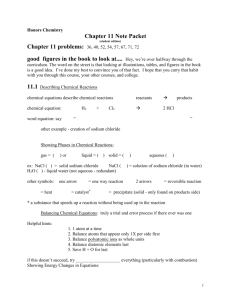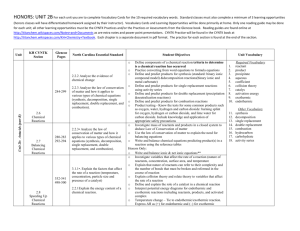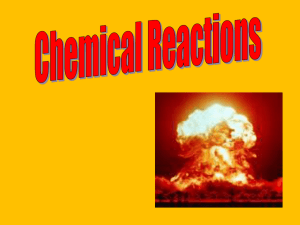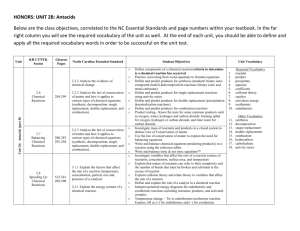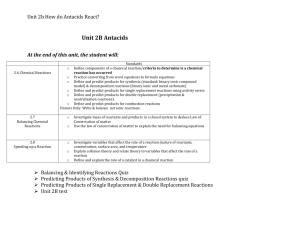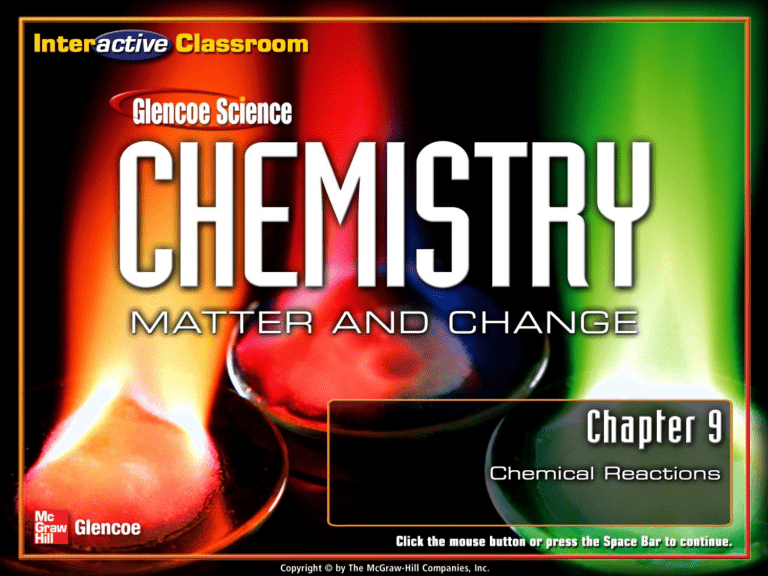
Chemical Reactions • The process by which one or more substances are rearranged to form different substances is called a chemical reaction. And rummy tummmy Chemical Reactions (cont.) • Evidence of a chemical reaction – Change in temperature – Change in color – Odor, gas, or bubbles may form. Representing Chemical Reactions • Chemists use statements called equations to represent chemical reactions. • Reactants are the starting substances. • Products are the substances formed in the reaction. • This table summarizes the symbols used in chemical equations. Diatomic elements • There are 8 elements that never want to be alone. • They form diatomic molecules. • H2 , N2 , O2 , F2 , Cl2 , Br2 , I2 , and At2 • The –ogens and the –ines • 1 + 7 pattern on the periodic table Representing Chemical Reactions (cont.) • In word equations, aluminum(s) + bromine(l) → aluminum bromide(s) reads as “aluminum and bromine react to produce aluminum bromide”. • Skeleton equations use symbols and formulas to represent the reactants and products. Al(s) + Br2(l) → AlBr3(s) • Skeleton equations lack information about how many atoms are involved in the reaction. Convert these to equations • Solid iron (III) sulfide reacts with gaseous hydrogen chloride to form iron (II) chloride and hydrosulfuric acid gas. • Nitric acid dissolved in water reacts with solid sodium carbonate to form liquid water and carbon dioxide gas and sodium nitrate dissolved in water. The other way • Fe(s) + O2(g) → Fe2O3(s) • Cu(s) + AgNO3(aq) → Ag(s) + Cu(NO3)2(aq) Representing Chemical Reactions (cont.) • A chemical equation is a statement that uses chemical formulas to show the identities and relative amounts of the substances involved in a chemical reaction. Balancing Chemical Equations • The most fundamental law in chemistry is the law of conservation of mass. • Balanced equations show this law. • Atoms can’t be created or destroyed • All the atoms we start with we must end up with • A balanced equation has the same number of each element on both sides of the equation. Balancing Chemical Equations • This figure shows the balanced equation for the reaction between aluminum and bromine. Balancing Chemical Equations (cont.) • A coefficient in a chemical equation is the number written in front of a reactant or product, describing the lowest whole-number ratio of the amounts of all the reactants and products. Rules for balancing • 1 Write the correct formulas for all the • • • • reactants and products 2 & 3 Count the number of atoms of each type appearing on both sides 4 Balance the elements one at a time by adding coefficients (the numbers in front) 5 Reduce if necessary 6 Check to make sure it is balanced. Never • Never change a subscript to balance an equation. • If you change the formula you are describing a different reaction. • H2O is a different compound than H 2O2 • Never put a coefficient in the middle of a formula • 2 NaCl is okay, Na2Cl is not. Example H2 + O2 → H2O Make a table to keep track of the elements Example H2 + O2 → H2O R P 2 H 2 2 O 1 Need twice as much O in the product Example H2 + O 2 → R P 2 H 2 2 O 1 Changes the O 2H O 2 Example H2 + O 2 → 2H O 2 R P 2 H 2 2 O 1 2 Also changes the H Example H2 + O 2 → 2H O 2 R P 2 H 2 4 2 O 1 2 Need twice as much H in the reactant Example 2H +O → 2 2 2H O 2 R P 2 H 2 4 2 O 1 2 Recount Example 2H +O → 2 2 2H O 2 R P 4 2 H 2 4 2 O 1 2 The equation is balanced, has the same number of each kind of atom on both sides Example 2H +O → 2 2 2H O 2 R P 4 2 H 2 4 2 O 1 2 This is the answer Not this Balancing Chemical Equations (cont.) Practice • CH4 + O2 → CO2 + H2O • AgNO3 + Cu → Cu(NO3)2 + Ag • Mg + N2 → Mg3N2 • P + O2 → P4O10 • Na + H2O → H2 + NaOH Section 9.1 Assessment Which of the following is NOT a chemical reaction? A. a piece of wood burning B. a car rusting D A 0% C D. red litmus paper turning blue A. A B. B C. C 0% 0% 0% D. D B C. an ice cube melting into water Section 9.1 Assessment What is the coefficient of bromine in the equation 2Al(s) + 3Br2(l) → 2AlBr3(s)? A. 1 B. 2 D A 0% C D. 6 A. A B. B C. C 0% 0% 0% D. D B C. 3 Types of Chemical Reactions • Chemists classify reactions in order to organize the many types • We will learn 5 types. • Will be able to predict the products. • For some we will be able to predict whether they will happen at all. • Will recognize them by the reactants Types of Chemical Reactions (cont.) • A synthesis reaction is a reaction in which two or more substances combine to produce a single product. • When two elements react, the reaction is always a synthesis reaction. Types of Chemical Reactions (cont.) • Predicting products of a synthesis reaction: • Element + Element compound • Fe + O2 Fe2O3 (you would be told iron (III)) – Rules of forming compounds must be followed • Predict the products – Calcium reacts with chlorine – Aluminum reacts with oxygen Types of Chemical Reactions (cont.) • In a combustion reaction, oxygen combines with a substance and releases energy in the form of heat and light. • Heated hydrogen reacts with oxygen to produce heat and water in a combustion reaction. This is also a synthesis reaction. Two specific types of combustion •If compound composed of only C, H and maybe O is reacted with oxygen, there are two possible outcomes •Complete combustion will produce CO 2 and H2O. •Incomplete combustion will produce CO and H2O. Predict Products of combustion reactions: •C4H10 + O2 → (complete) •C4H10 + O2 → (incomplete) •C6H12O6 + O2 → (complete) •C8H8 + O2 → (incomplete) •Mg + O2 Decomposition Reactions • A decomposition reaction is one in which a single compound breaks down into two or more elements or new compounds. • Decomposition reactions often require an energy source, such as heat, light, or electricity, to occur. • Compound Element or compound + Element or compound • Predicting Products of Decomposition • Easily predict the products if it is a binary compound • Made up of only two elements • Compound will fall apart into its elements electricity → electricity • H2O → heat → • HgO Replacement Reactions • A reaction in which the atoms of one element replace the atoms of another element in a compound is called a single replacement reaction. A + BX → AX + B • We can tell whether a reaction will happen • Some elements are more reactive than others • Use Activity Series List • More reactive replaces less reactive – Higher on the list replaces lower. – If the element by itself is higher, reaction occurs, if lower it doesn’t Replacement Reactions (cont.) • Fe + CuSO4 → • Pb + KCl → • Al + HCl → • What does it mean that Ag, Pt and Au are on the bottom of the Activity Series List? Replacement Reactions (cont.) • Halogens frequently replace other halogens in replacement reactions. • Halogens also have different reactivities and do not always replace each other. • The order of activity is on the periodic table. • Higher replaces lower. • F2 + HCl → • Br2 + KCl → Replacement Reactions (cont.) • Double replacement reactions occur when ions exchange between two compounds. • This figure shows a generic double replacement equation. Replacement Reactions (cont.) • A solid product produced during a chemical reaction in a solution is called a precipitate. • All double replacement reactions produce either water, a precipitate, or a gas. Complete and Balance •assume all of the reactions take place. •CaCl2 + NaOH → •CuCl2 + K2S → •KOH + Fe(NO3)3 → •(NH4)2SO4 + BaF2 → Replacement Reactions (cont.) • This table summarizes different ways to predict the products of a chemical reaction. Examples • H2 + O2 → • H2O → • Zn + H2SO4 → • HgO → • KBr +Cl2 → • AgNO3 + NaCl → • Mg(OH)2 + H2SO3 → Section 9.2 Assessment Which of the following is NOT one of the four types of reactions? A. deconstructive B. synthesis D A 0% C D. double replacement A. A B. B C. C 0% 0% 0% D. D B C. single replacement Section 9.2 Assessment The following equation is what type of reaction? KCN(aq) + HBr(aq) → KBr(aq) + HCN(g) A. deconstructive A 0% D D. double replacement C C. single replacement A. A B. B C. C 0% 0% 0% D. D B B. synthesis Aqueous Solutions • An aqueous solution contains one or more dissolved substances (called solutes) in water. • The solvent is the most plentiful substance in a solution. Aqueous Solutions (cont.) • Water is always the solvent in an aqueous solution. • There are many possible solutes—sugar and alcohol are molecular compounds that exist as molecules in aqueous solutions. • Compounds that produce hydrogen ions in aqueous solutions are acids. Aqueous Solutions (cont.) • Ionic compounds can also be solutes in aqueous solutions. • When ionic compounds dissolve in water, their ions separate in a process called dissociation. Types of Reactions in Aqueous Solutions • When two solutions that contain ions as solutes are combined, the ions might react. • If they react, it is always a double replacement reaction. • Three products can form: precipitates, water, or gases. Types of Reactions in Aqueous Solutions (cont.) • Aqueous solutions of sodium hydroxide and copper(II) chloride react to form the precipitate copper(II) hydroxide. 2NaOH(aq) + CuCl2(aq) → 2NaCl(aq) + Cu(OH)2(s) • Ionic equations that show all of the particles in a solution as they actually exist are called complete ionic equations. 2Na+(aq) + 2OH–(aq) + Cu2+ (aq)+ 2Cl–(aq) → 2Na+ (aq) + 2Cl–(aq) + Cu(OH)2(s) Types of Reactions in Aqueous Solutions (cont.) • Ions that do not participate in a reaction are called spectator ions and are not usually written in ionic equations. • Formulas that include only the particles that participate in reactions are called net ionic equations. 2OH–(aq) + Cu2+(aq) → Cu(OH)2(s) Types of Reactions in Aqueous Solutions (cont.) • Some reactions produce more water molecules. • No evidence of a chemical reaction is observable. HBr(aq) + NaOH(aq) → H2O(l) + NaBr(aq) • Without spectator ions H+(aq) + OH–(aq) → H2O(l). Types of Reactions in Aqueous Solutions (cont.) • Gases that are commonly produced are carbon dioxide, hydrogen cyanide, and hydrogen sulfide. 2HI(aq) + Li2S(aq) → H2S(g) + 2LiI(aq) Section 9.3 Assessment What is the solvent in an aqueous solution? A. hydrogen B. sodium ions D A 0% C D. alcohol A. A B. B C. C 0% 0% 0% D. D B C. water Section 9.3 Assessment An equation that includes only the particles that participate in a reaction is called: A. net ionic equation A 0% D D. reduced ionic equation C C. complete ionic equation A. A B. B C. C 0% 0% 0% D. D B B. spectator ions Section 9.1 Reactions and Equations Key Concepts • Some physical changes are evidence that indicate a chemical reaction has occurred. • Word equations and skeleton equations provide important information about a chemical reaction. • A chemical equation gives the identities and relative amounts of the reactants and products that are involved in a chemical reaction. • Balancing an equation involves adjusting the coefficients until the number of atoms of each element is equal on both sides of the equation. Section 9.2 Classifying Chemical Reactions Key Concepts • Classifying chemical reactions makes them easier to understand, remember, and recognize. • Activity series of metals and halogens can be used to predict if single-replacement reactions will occur. Section 9.3 Reactions in Aqueous Solutions Key Concepts • In aqueous solutions, the solvent is always water. There are many possible solutes. • Many molecular compounds form ions when they dissolve in water. When some ionic compounds dissolve in water, their ions separate. • When two aqueous solutions that contain ions as solutes are combined, the ions might react with one another. The solvent molecules do not usually react. • Reactions that occur in aqueous solutions are doublereplacement reactions. The law of conservation of mass requires what in a chemical reaction equation? A. both sides of the equation to contain the same substances A 0% D D. the products to have fewer molecules than the reactants C C. both sides to have the same amount of atoms of each element A. A B. B C. C 0% 0% 0% D. D B B. the reactants to have the same amount of molecules as the products A reaction that gives off heat is what type of reaction? A. single replacement reaction B. double replacement reaction D A 0% C D. combustion reaction A. A B. B C. C 0% 0% 0% D. D B C. synthesis reaction Ions that are present in a solution and do not participate in a chemical reaction when another substance is added are called ____. A. spectator ions A 0% D D. net ions C C. products A. A B. B C. C 0% 0% 0% D. D B B. reactants A double replacement reaction produces all of the following except ____. A. gases B. solids D A 0% C D. water A. A B. B C. C 0% 0% 0% D. D B C. light What type of reaction is the following? 2H2O(l) + energy → H2(g) + O2(g) A. synthesis reaction A 0% D D. replacement reaction C C. combustion reaction A. A B. B C. C 0% 0% 0% D. D B B. decomposition reaction What type of reaction is the following? 2H2(g) + O2(g) → 2H2O(l) A. replacement reaction A 0% D D. double replacement reaction C C. combustion reaction A. A B. B C. C 0% 0% 0% D. D B B. synthesis A precipitate forms in a double replacement reaction only if: A. the reactivities of the compounds differ D A D. the new compound is not soluble in water 0% C C. the new compound is soluble in water A. A B. B C. C 0% 0% 0% D. D B B. the new compound is denser than water A ____ is a statement that uses chemical formulas to show the identities and relative amounts of the substances involved in a chemical reaction. A. word equation A 0% D D. balanced equation C C. chemical equation A. A B. B C. C 0% 0% 0% D. D B B. skeleton equation Predict the type of reaction. LiBr2 (aq) + 2NaOH (aq) → ____ A. synthesis reaction A 0% D D. double replacement reaction C C. single replacement reaction A. A B. B C. C 0% 0% 0% D. D B B. combustion reaction Which reactions are essentially the opposite of synthesis reactions? A. single-replacement B. decomposition D A 0% C D. double-replacement A. A B. B C. C 0% 0% 0% D. D B C. combustion
